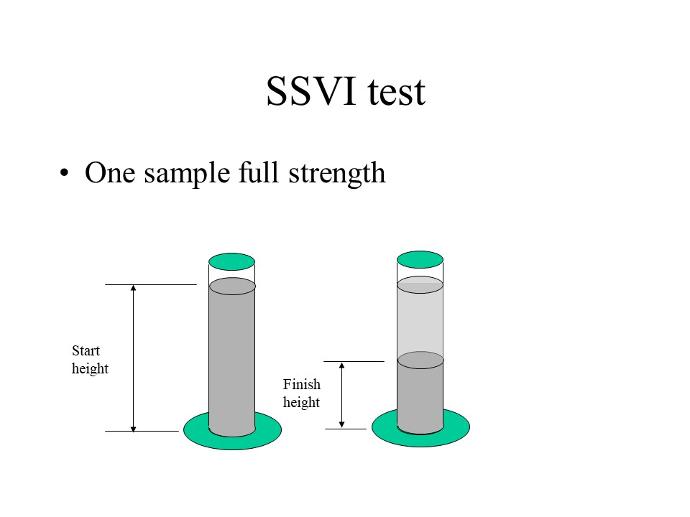
The stirred sludge volume index (SSVI) is one of the most widely used tests for determining the settling properties of an activated sludge. It is a very simple and rapid test that provides a lot of information, which can be used in the routine operation and control of an activated sludge plant. Perhaps the majority of plant operators use the SSVI test simply to assess whether an activated sludge settles well or whether it is experiencing sludge bulking. However, it can provide a lot more useful information than this:
- It can indicate potential operating problems with the aeration basin
- and it can be used to ensure that the final sedimentation tank is operating efficiently.
Performing the SSVI Test
SSVI is not independent of the initial solids concentration,
and consequently it is important to report the value of the SSVI at a standard
concentration of 3.5 g/L. It is thus
referred to as the SSVI3.5. In the UK the SSVI3.5 is the routine sludge settleability
measure and used extensively for the design and control of secondary
sedimentation tanks.
To obtain the SSVI at 3.5 g/L two SSVI tests are required. The first is performed using the sludge as it, then a second with the sludge diluted to 50% solid by adding and equal amount of final effluent.
Having determined the solids loading the two points are plotted and the SSVI3.5 calculated.

Typical problems encountered with sludges settling in the
Triton Settling Apparatus
Observation
| SSVI3.5 (mL/g)
|
Problem
|
Sludge settles well with a distinct interface
and clear supernatan
| <90
| Well operated treatment plant
|
Sludge settles poorly but with a distinct interface and a clear supernatant | >120 | Filamentous bulking – confirm by microscopic analysis
|
Sludge settles poorly, no distinct interface, supernatant cloudy, large amounts of scum/foam on surface | Difficult to measure/ >120
| Foaming – confirm by
microscopic analysis of foam for presence of Nocardia spp. and M.
parvicella |
Some sludge settlement but with no distinct interface. Supernatant very turbid containing a lot of small flocs. No foam or scum on surface. | Difficult to measure
| Toxic compounds may be present in influent, causing some inhibition and toxicity, particularly of ciliated protozoa – confirm by microscopy. |
Very little or no sludge settlement. Sludge does not form flocs and comprises dispersed, small clumps | Can’t be measured
| Severe toxic shock due to toxic compounds in influent
|
Sludge settles well with a distinct interface,
but towards the end of the test (or later) the sludge rises to the surface of
the apparatus. Small gas bubbles
observed attached to sludge flocs
| 60 -100
| Nitrification occurring in the aeration basin, leading to denitrification of nitrate to nitrogen gas in the final clarifier. |